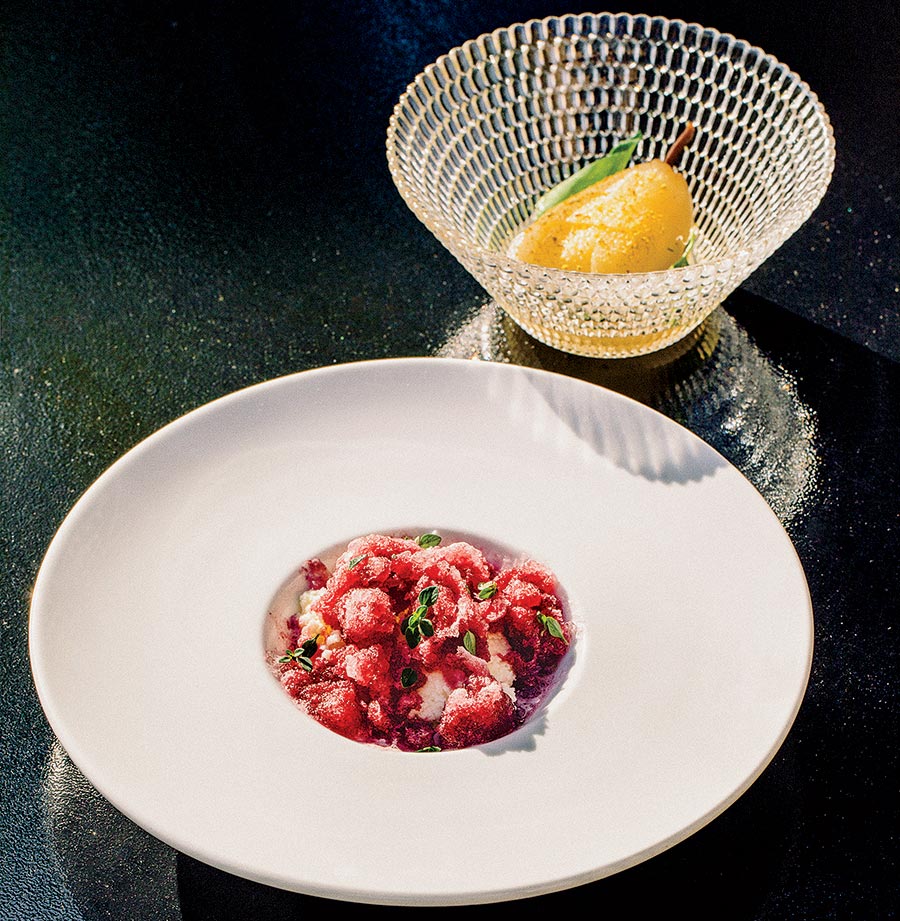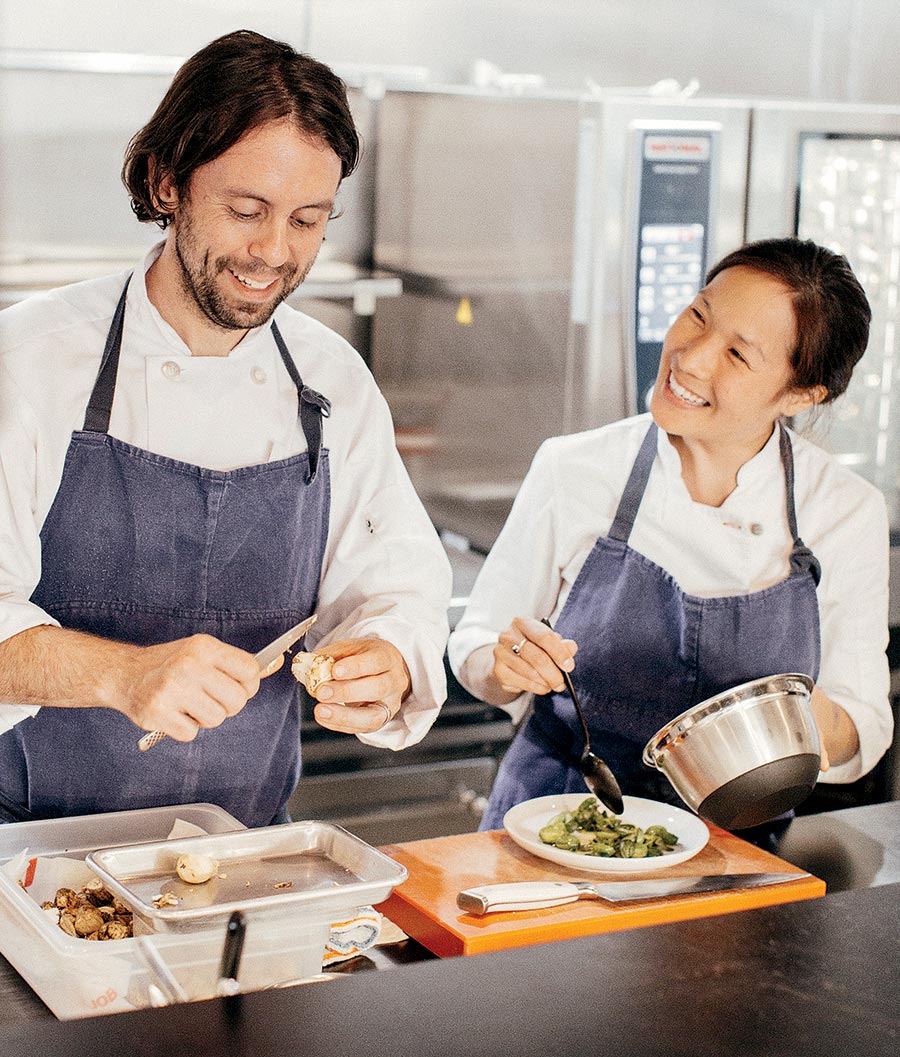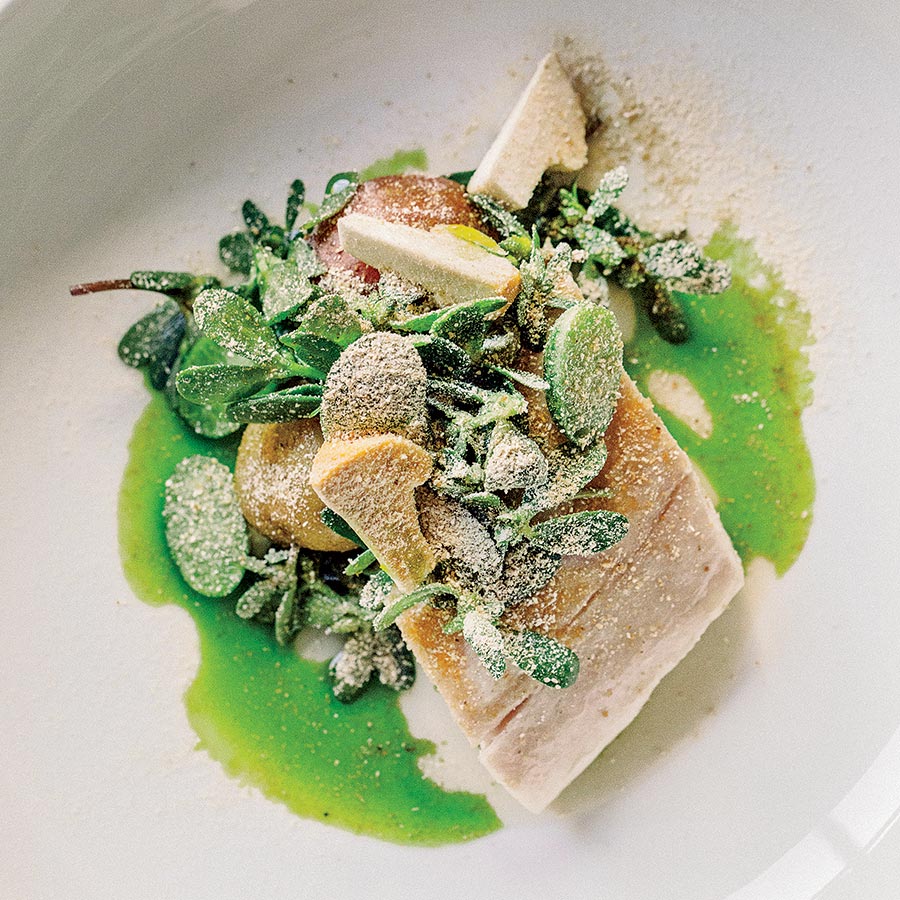
Beverly Kim wove between the tight tables at Wherewithall, her latest restaurant, on a Thursday night, toting a 3-month-old baby. The room, which once housed an auto parts shop but is now all industrial felt and salvaged red pine, was bursting with energy. Every spot on the long gray banquette in the middle of the room was taken, all the chefs in the open kitchen were firing, and staffers hoisting gorgeous plates could barely get past others punching in orders. So the sight of the award-winning chef amid the chaos, working the room with an adorable hunk of drool and charisma in her arms, made it hard not to fall in love with the whole crazy scene.
Wherewithall is the follow-up to Parachute, the idiosyncratic five-year-old Korean American spot a couple of doors up Elston Avenue that won Kim and her husband, co-chef Johnny Clark, a James Beard Award in May. Every time I visit Parachute, I’m a little more impressed by how fearlessly they follow their off-kilter muse — the restaurant showcases a liberal approach to flavors that’s both weird and smart, and there’s nothing else quite like it in Chicago.
At Wherewithall, they give their whims even freer rein. The restaurant’s cuisine is impossible to classify. The four-course prix fixe menu (more like eight or nine courses when you tally up the extra bites) is seemingly based on little more than the chefs’ ability to improvise with whatever seasonal ingredients they have on hand. Clark likens it to Tetris, with the produce in the cooler serving as blocks. “We can’t waste it, so it’s about placing the last block in a great location,” he says. “Before you know it, another one is coming, so you start plotting before the last block is placed. The game never ends, and the stakes are high.”
All this may sound horribly stressful, and in lesser hands it’d be a potential minefield. But at Wherewithall, the challenge yields a refreshing unpredictability — and Kim and Clark’s instincts are almost always right. The trio of amuse-bouches that preceded my meal included onion rings dusted with smoky ground black lime, roasted broccoli stalks dipped in Alpine cheese sauce, and a small bowl of garlicky ajo blanco harboring a single submerged Fritz almond. At first I tried to find a uniting principle among these three initial sorties, but then realized that was beside the point.
A course of cubed beets sprinkled with flowering dill and sorrel and accompanied by a Jonah crab–laced crème fraîche constituted a riff on a dish that the kitchen had reworked after deeming a smoky bacon version too rich. They eighty-sixed the pork, replacing it with lightly smoked beets: better balance, deeper flavors.

Its first day on the menu, the Atlantic hake was already an understated masterpiece. The chefs had been serving Spanish mackerel with peppers and were ready for something lighter. So they seasoned hake with salt and a vin jaune sauce reduction made with butter and shallots and slowly baked it. They paired it with the petite, tender French green beans from Nichols Farm & Orchard that Clark had found at Green City Market, which needed nothing beyond a little steam and a roll in olive oil. The delicate fillet soaked up the decadent vin jaune sauce, absorbing the buttery, sherry-like flavor, and was adorned with little nubs of baby corn that added bursts of texture — because, hey, corn and butter.
In serving a composition of sweetbreads and lima beans, the kitchen dared diners to confront two potential flash points at once — organ meat plus the source of many a childhood dinnertime argument, together on one plate? But Kim and Clark pulled off the union beautifully, playing the unctuousness of the sweetbreads off the starchiness of the legumes, with sweet-and-sour tomatoes on the side. One bite and you were suddenly thinking, Everyone loves sweetbreads and lima beans, right? And yet, a few days later, the sweetbreads were out, chicken was in, and the lima beans had migrated to the hake dish.
The staff must have aneurysms trying to remember everything from day to day. But the servers are approachable, knowledgeable, and cheeky: Ours kept food descriptions to a minimum to get us asking questions, and it worked. A cucamelon-studded plum sorbet, we were told upon inquiring, was made with Shiro plums, a tart Japanese variety. The chefs had a whole case from Seedling Farms and needed to serve them while they were ripe. Needless to say, they were. This puckery intermezzo annihilated all traces of the dishes that came before. It was, frankly, a bit much. So were the wine pairings ($45). I tip my hat to the unexpected choices, such as the dry, caramel-toned Andalusian Gómez Nevado Dorado Seco, a natural pairing with vin jaune sauce, but too often the connections felt more showy than satisfying.

The last course, mint ice cream topped with chocolate mousse, was both. Clark says he was working the pastry station one night when he started missing his kids. (That new baby is their third.) Using the chocolate mint leaves he had cut from the Parachute garden, he created an homage to his children’s favorite dessert, mint chocolate chip ice cream, and hid raspberries and cocoa nibs beneath the mousse as little treasures. “It was like giving a good-night kiss to my kids,” he says.
Wherewithall is a warm, wonderful follow-up to Parachute; it’s neither flashy nor gimmicky, boldly finding its own way night after night through reinvention and ingenuity. And despite all the moving parts — or maybe because of them — the experience adds up to something rewarding for diners. I don’t know how Clark and Kim do it, but in the grand Tetris game at Wherewithall, every block clicks into place.



